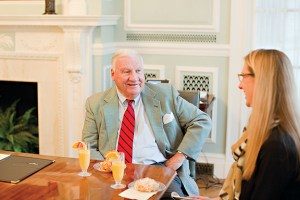Sonny with a Chance of Midnight
By Savannah Magazine
To mark the 20th anniversary of the infamous “Book,” Andrea Goto cross-examines one of its real-life characters to find out how much our little “Garden” has grown. » Photography by Katie McGee
A real-life character steps off the page and into Andrea Goto’s path.
“Have you read ‘The Book?’”
As a transplant from the North at the turn of this century, I expected to encounter the South’s doggedly devout, but this question was too much. Thankfully, it didn’t take me long to realize that the book in question was not the Word of God, but rather John Berendt’s bestselling novel, Midnight in the Garden of Good and Evil—a close second. The more blasphemous among us might argue that Berendt’s novelization of Jim Williams’ four trials for the murder of Danny Hansford has shaped the city of Savannah as much or more than the Good Book itself.
As we celebrate 20 years of Midnight, outsiders still flock to the city Berendt painted as darkly charming and warmly debaucherous.
But familiarity breeds contempt, as they say. I’ll be the first to admit that, not too long ago, I was one Bird Girl figurine away from an old-fashioned Book burning. That is until one of the characters stepped from its pages and into my path.
Sonny Seiler, the lawyer who defended Williams in the last three of his four trials, describes himself as a “cracker” from Savannah. But I’m told Sonny is the embodiment of everything I like best about this city: its generosity, irreverence and talent for telling a damn good story.
So I put down my matches, pushed aside the burn barrel and sidled up to Sonny one morning at the stately Armstrong House, which a forerunner of the law firm Bouhan Falligant purchased from Williams in 1970. I come bearing gifts of mimosas and Back in the Day Bakery biscones in exchange for some true confessions from the Garden of Good and Evil.
Sonny didn’t disappoint.
Meet Our Guest
Frank “Sonny” Seiler was Jim Williams’ lead defense attorney in the series of murder trials that are central to the book and film version of Midnight. He is a senior law partner at Bouhan Falligant and he has appeared as an actor in three Hollywood films. Sonny breeds and owns the famous Uga bulldogs—mascots for the University of Georgia, where he graduated law school.
Savannah Magazine: You represented Jim Williams even before the murder trial and knew him quite well. Tell me a little about his character.
Sonny: What a smart guy he was! Jim was a peculiar worker. He worked at night and he slept in the daytime. I never could get him to do anything on the cases until around 3 o’clock and then he insisted I come over (to Mercer House). Then we’d have a vodka and tonic, which he liked. Or two. Or three. And I’d get maybe an hour’s work out of him on the case.
SM: It doesn’t sound like he was too concerned.
Sonny: He had the feeling, “Look, I’m not guilty. I know you can prove it. You will prove it—you don’t need me. For all this stuff you do, send me a bill and I’ll pay it.” That’s about the way it went. But I did need him because he was gonna have to testify. We needed him to prove self-defense because there was no other witness.
SM: How did he do?
Sonny: Throughout all four trials he never contradicted himself one time on the stand. And it was hell to get him to sit down just to read his testimony from the previous trial. He said, “I know all that. I lived through it.” He was very flippant about things like that. You wouldn’t think he had his neck in a noose, so to speak.
SM: John Berendt moved to Savannah in 1985 when you were preparing for trial two. When did he get in touch with you about the book?
Sonny: Immediately. Berendt’s an amazing guy. I got to know him personally and liked him very much. But Jim was in jail and I couldn’t tell John all he wanted to know because the case was ongoing. John knew that I couldn’t answer any of the questions he really wanted to be answered. So he went about trying to find answers in his own way and he did a pretty good job of it.
He would bring me news of what was being said in the street, and that was helpful.
SM: Were you at all concerned knowing this book was being written about your client?
Sonny: I couldn’t do anything about it. I had enough to be nervous about (laughing) than to worry about what John Berendt was writing.
SM: Take us back 20 years. How was the book first received in Savannah?
Sonny: Mixed emotions. One faction thought it was just a travesty of justice for a Yankee writer to come down here and spread gossip about Savannah and that’s what pissed ’em off more than anything. It wasn’t the book. But they did not think that the book cast Jim in a good light. The book had a lot in it about his homosexual tendencies, which most of his friends knew. Anybody who stayed around him should know. But that got publicized and ballyhooed by the paper here, which really, they were trying him for being “queer,” as we said. Not for murder.
Back in those days, (homosexuality) was an unpardonable sin in a sleepy Southern town like Savannah. It offended juries. We couldn’t escape that.
Little did they know what went on in this city. And gradually, whether they liked it or not, (the book) became popular.
SM: But the details of the book are most accurate?
Sonny: He changed a lot of the names to—as they used to say—“protect the innocent.” Well, I don’t know how innocent they were, but he didn’t change any of the facts.
SM: Was there a backlash from the book?
Sonny: Not on me, except that people would call and harass me for representing Jim—accuse me of being sympathetic to homosexuals and all that stuff. My wife got used to that. I got used to it. And we just ignored it.
On the other side, it’s been very rewarding to see how the legal community received it. I have made hundreds of talks on this book to different audiences. I have one talk strictly for lawyers and judges that highlights the evidentiary facts and all.
SM: The case went on for eight years. I can only imagine the toll that took on everyone.
Sonny: That case cost Jim Williams millions. It went to the Supreme Court three times. And you don’t go up there on buttons. All that takes time and money.
SM: How did you come about getting involved in the 1997 film adaptation of the book?
Sonny: I got a call from somebody who was working on the movie and said, “Clint Eastwood wants to come to Savannah.” He came with (production designer) Mr. (Henry) Bumstead, who was a two-time Academy Award winner for art direction. They wanted to go over to Mercer House. And I said, “Good luck with that, but I will call (Jim’s sister, Dorothy “Dot” Kingery) and see if she will receive you,” because I still represent her.
So they flew down here, five or six of ’em, and (Eastwood) wanted to see Uga because he was going to be in the movie. So my wife brought Uga down here and we were sitting right in that white chair there. (Gestures at a chair in the foyer.)
Clint Eastwood didn’t wait to be introduced to anybody. He dropped down on the floor—you know, they wear jeans and all that there, they don’t ever dress up—and he started rubbing Uga’s head and he said, “Uga, I’m gonna make you a celebrity.”
And my wife said, “Mr. Eastwood, Uga’s already a celebrity.”
SM: How did things go with Dorothy?
Sonny: I told Clint, “She ain’t gonna let you use this house in this movie because she’s very sensitive about what happened here.”
Damn if she didn’t do it. Clint is a charmer. I’ll tell you what: He has no problem with the ladies or anybody else. But she had one deal: That they could not film any of the “unpleasantness,” as she calls it, there. So they did all of that out at Warner Bros. But she let them film the house, the parties in there, and they were very pleased with it and so was she.
SM: Was that a long time coming?
Sonny: Dot Kingery didn’t like the book. She kept everything hush-hush, but now she lets tourists go through Mercer-Williams House. But they cannot talk about the unpleasantness or what went on in that study on the first floor.
It just shows you how people have warmed up and what the book and the movie have meant to Savannah. Before this (movie), Dot wouldn’t have anything to do with John Berendt or anything that would demean her brother. She wanted her brother to be known as a reconstructionist—which he was. Preservationist—which he was. Antique dealer—which he was. But not somebody who shot somebody. A “lover,” as they say.
SM: In the film, Jack Thompson plays your character, but you still ended up having a role.
Sonny: I had a deal with (screenwriter) John Lee Hancock that he would get me on the jury. I wanted to be the foreperson who stood up at the end and said, “We the jury find the defendant not guilty.” That’s what I wanted more than anything because that would quietly stick my tongue out at a lot of people.
But Phyllis Hoffman, she was the casting director, she says to me, “You’re gonna be the judge.” She said, “Lemme tell you how this works. Clint says that you’re the right age, you have the right looks, you have the right voice and if you’ll be the judge, he won’t have to hire a voice coach to transpose somebody’s other lingo into being a cracker boy down here in Savannah.” (Laughing.)
I said to myself, “I’ve been before enough goddamn judges to know how to do this part.” I thoroughly enjoyed it.
SM: But you began as a consultant on the film?
Sonny: Yeah. And I’m listed as that in the credit. Every time I suggested something, they would immediately do it. Nobody argued with me. The only thing I could never get them to do was to eliminate Chablis. Now, I like Chablis. She’s an interesting guy. But Chablis did not know Jim Williams. And she certainly didn’t find the records at Candler hospital that lead to the acquittal.
I said, “Clint, really it’s almost unforgivable. She’s got no place in this if you want it to be real.” He said, “Sonny, don’t worry about it. They like people like her out there.”
And she did a good job in the movie. In the scene when she gets down from the stand and tries to take over the trial, I told Clint that she was apt to just take off on her own and ad lib. And damned if she didn’t do it. Clint never criticizes anybody on the set; never hollers at anybody. But I saw him quietly take her over to the side and they were talkin’. She never ventured away again. And she did a very good performance, I thought—and he thought, too.
SM: So many of Savannah’s characters made it into the book and the film.
Sonny: In the Historic District, down here where it all happened? Same people. Same families. We don’t have much turnover down here. I mean, Ed Hill’s been there for years. The Duncans, they ain’t going anywhere. (Emma) Adler, she’s not going anywhere. Dorothy’s not going anywhere.
SM: You’re a character, too.
Sonny: I’ve accepted that over the years. (Laughter.)
Then they had a big reception for all the people that had anything to do with the book. That was the first time I ever saw Chablis. She stood out. Of course, she was one of the few black ladies at the party. But she had on this knit St. John’s dress that clung to every curve. And she really looked good. She does not buy cheap stuff.
SM: What other characters have stuck with you?
Sonny: One of the people that impressed me most was the real Minerva (Valerie Fennel Aiken Boles). She was very, very nice. She liked John Berendt. Of course, she loved Jim. I remember her because Jim had introduced me to her a couple of times out in (Forsyth Park). She’d come to hang out there and Jim would give her $20 or something because she’d tell him what was going on in the community, which he valued. She was his mole.
He’d say, “C’mon Sonny, there’s Minerva sitting out there. Let’s go talk to her.” I said, “No, Jim, you go talk to Minerva, I’ll go back and work on your case. We’ll let her handle magic and I’ll handle the law.”
She died not long ago.
SM: Even after two decades, does “The Book” continue to shape how people see Savannah?
Sonny: To show you that this book has a life of its own, as we say, people still wander in this building off the street because they recognize it is in the movie. They want to see the rooms that the movie was shot in. That happens all the time because they’re traveling around with that map in their hands that tells them different places, like the Oglethorpe Club. They try to get in the Oglethorpe Club all the time, but of course, they can’t get to first base there.
To my knowledge, there are now three tour companies that give tours of Midnight. And they’re very good. They lie a lot and it pisses off some of my partners—mainly Walter Hartridge. When they come by here, they’ll say, “This is the law firm of Sonny Seiler. He represented Jim Williams.” Well, that pisses 23 other lawyers off.
But all of those things are indication of the fact that this book lives on. It reaches its peak every April when all the azaleas come out and all the people come to Savannah. This has taken the place of a lot of the old historic tours. They want to see Savannah, but they want to see it through the eyes of John Berendt and Midnight.
SM: Will there ever be another “Book?”
Sonny: They write a book about Savannah every day!
SM: No, a good one.
Sonny: Somethin’ good has got to happen first.



